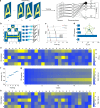Tactile sensory coding and learning with bio-inspired optoelectronic spiking afferent nerves
- PMID: 32170075
- PMCID: PMC7070032
- DOI: 10.1038/s41467-020-15105-2
Tactile sensory coding and learning with bio-inspired optoelectronic spiking afferent nerves
Abstract
The integration and cooperation of mechanoreceptors, neurons and synapses in somatosensory systems enable humans to efficiently sense and process tactile information. Inspired by biological somatosensory systems, we report an optoelectronic spiking afferent nerve with neural coding, perceptual learning and memorizing capabilities to mimic tactile sensing and processing. Our system senses pressure by MXene-based sensors, converts pressure information to light pulses by coupling light-emitting diodes to analog-to-digital circuits, then integrates light pulses using a synaptic photomemristor. With neural coding, our spiking nerve is capable of not only detecting simultaneous pressure inputs, but also recognizing Morse code, braille, and object movement. Furthermore, with dimensionality-reduced feature extraction and learning, our system can recognize and memorize handwritten alphabets and words, providing a promising approach towards e-skin, neurorobotics and human-machine interaction technologies.
Conflict of interest statement
The authors declare no competing interests.
Figures





References
-
- Wang Z, et al. Fully memristive neural networks for pattern classification with unsupervised learning. Nat. Electron. 2018;1:137–145. doi: 10.1038/s41928-018-0023-2. - DOI
Publication types
MeSH terms
LinkOut - more resources
Full Text Sources

